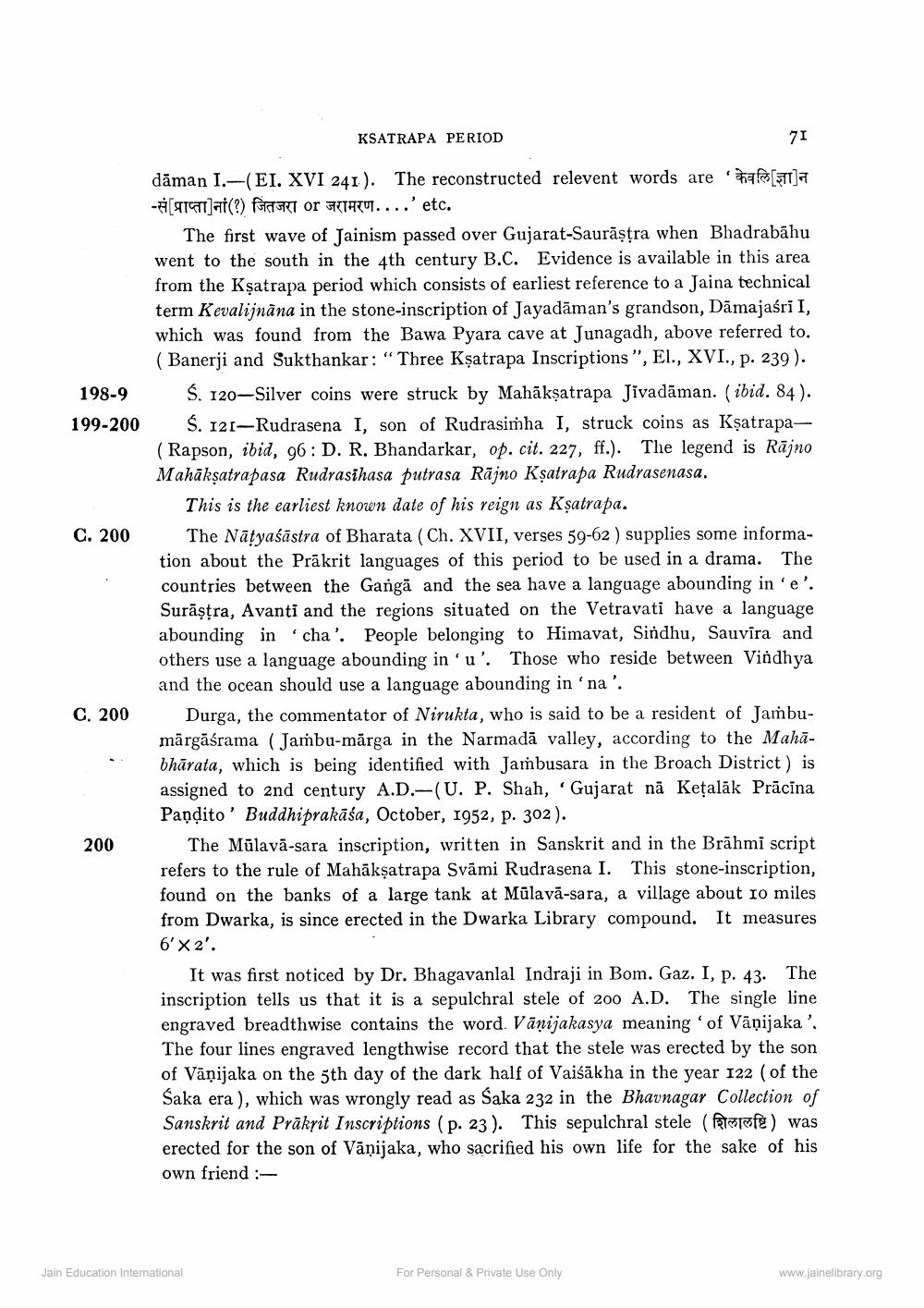________________
KSATRAPA PERIOD
71
198-9 199-200
C. 200
dāman 1.-(EI. XVI 241). The reconstructed relevent words are als [511] -#(TTCT]at(?) Fiskt or FTATU....' etc.
The first wave of Jainism passed over Gujarat-Saurāşțra when Bhadrabāhu went to the south in the 4th century B.C. Evidence is available in this area from the Kşatrapa period which consists of earliest reference to a Jaina technical term Kevalijnāna in the stone-inscription of Jayadāman's grandson, Dāmajasri I, which was found from the Bawa Pyara cave at Junagadh, above referred to. (Banerji and Sukthankar: "Three Kşatrapa Inscriptions", El., XVI., p. 239).
Ś. 120-Silver coins were struck by Mahākṣatrapa Jivadāman. (ibid. 84).
S. 121-Rudrasena I, son of Rudrasimha I, struck coins as Kşatrapa(Rapson, ibid, 96: D. R. Bhandarkar, op. cit. 227, ff.). The legend is Rājno Mahākṣatrapasa Rudrasihasa putrasa Rājno Ksatrapa Rudrasenasa.
This is the earliest known date of his reign as Ksatrapa.
The Nātyaśāstra of Bharata (Ch. XVII, verses 59-62 ) supplies some information about the Prākrit languages of this period to be used in a drama. The countries between the Gangā and the sea have a language abounding in 'e'. Surāṣtra, Avanti and the regions situated on the Vetravati have a language abounding in 'cha'. People belonging to Himavat, Sindhu, Sauvira and others use a language abounding in 'u'. Those who reside between Vindhya and the ocean should use a language abounding in 'na'.
Durga, the commentator of Nirukta, who is said to be a resident of Jambumārgāśrama (Jambu-mārga in the Narmadā valley, according to the Mahābhārata, which is being identified with Jambusara in the Broach District ) is assigned to 2nd century A.D.-(U. P. Shah, Gujarat nā Ketalāk Prācina Paņdito' Buddhiprakāśa, October, 1952, p. 302).
The Mūlavā-sara inscription, written in Sanskrit and in the Brāhmi script refers to the rule of Mahākṣatrapa Svāmi Rudrasena I. This stone-inscription, found on the banks of a large tank at Mūlavā-sara, a village about 10 miles from Dwarka, is since erected in the Dwarka Library compound. It measures 6'X2'.
It was first noticed by Dr. Bhagavanlal Indraji in Bom. Gaz. I, p. 43. The inscription tells us that it is a sepulchral stele of 200 A.D. The single line engraved breadthwise contains the word. Vānijakasya meaning of Vāņijaka'. The four lines engraved lengthwise record that the stele was erected by the son of Vānijaka on the 5th day of the dark half of Vaišākha in the year 122 (of the Saka era), which was wrongly read as Saka 232 in the Bhavnagar Collection of Sanskrit and Prākrit Inscriptions (p. 23). This sepulchral stele (Refe) was erected for the son of Vānijaka, who sacrified his own life for the sake of his own friend :
C. 200
200
Jain Education International
For Personal & Private Use Only
www.jainelibrary.org




